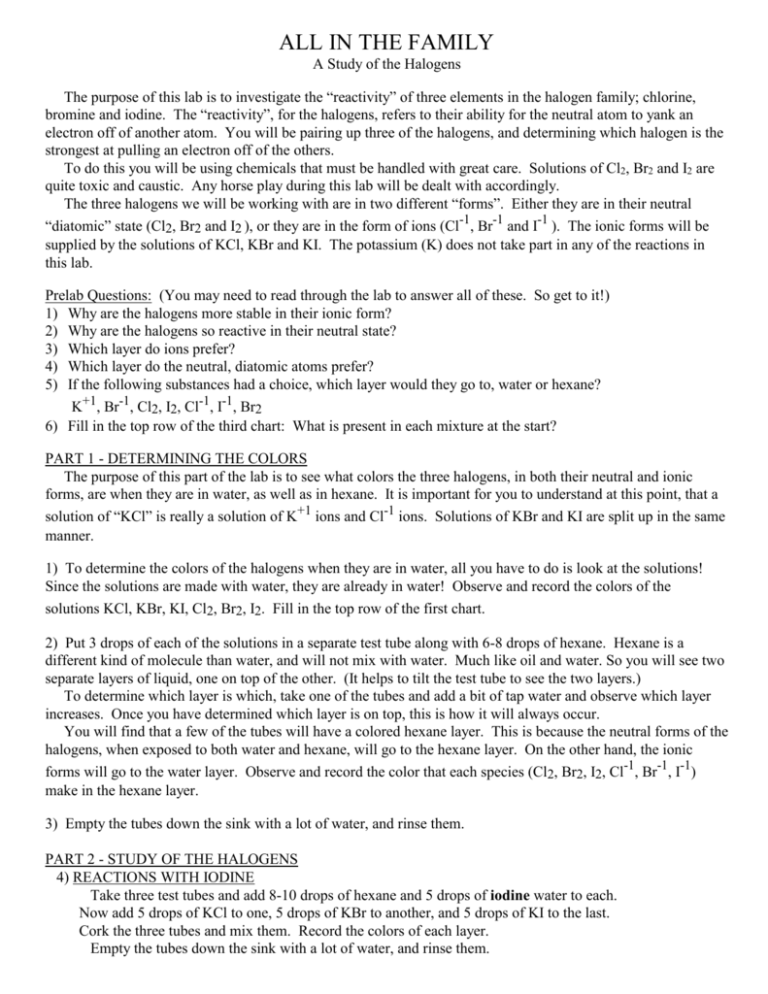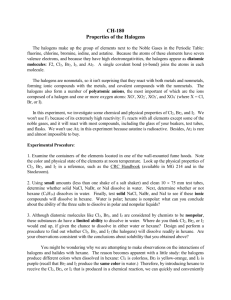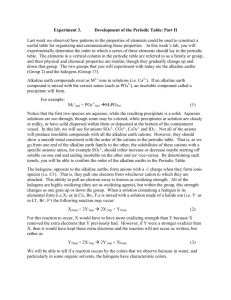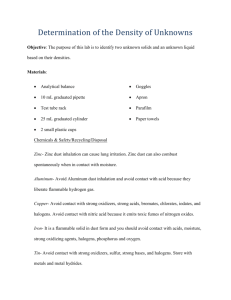questions / conclusions
advertisement

ALL IN THE FAMILY A Study of the Halogens The purpose of this lab is to investigate the “reactivity” of three elements in the halogen family; chlorine, bromine and iodine. The “reactivity”, for the halogens, refers to their ability for the neutral atom to yank an electron off of another atom. You will be pairing up three of the halogens, and determining which halogen is the strongest at pulling an electron off of the others. To do this you will be using chemicals that must be handled with great care. Solutions of Cl2, Br2 and I2 are quite toxic and caustic. Any horse play during this lab will be dealt with accordingly. The three halogens we will be working with are in two different “forms”. Either they are in their neutral “diatomic” state (Cl2, Br2 and I2 ), or they are in the form of ions (Cl-1, Br-1 and I-1 ). The ionic forms will be supplied by the solutions of KCl, KBr and KI. The potassium (K) does not take part in any of the reactions in this lab. Prelab Questions: (You may need to read through the lab to answer all of these. So get to it!) 1) Why are the halogens more stable in their ionic form? 2) Why are the halogens so reactive in their neutral state? 3) Which layer do ions prefer? 4) Which layer do the neutral, diatomic atoms prefer? 5) If the following substances had a choice, which layer would they go to, water or hexane? K+1, Br-1, Cl2, I2, Cl-1, I-1, Br2 6) Fill in the top row of the third chart: What is present in each mixture at the start? PART 1 - DETERMINING THE COLORS The purpose of this part of the lab is to see what colors the three halogens, in both their neutral and ionic forms, are when they are in water, as well as in hexane. It is important for you to understand at this point, that a solution of “KCl” is really a solution of K+1 ions and Cl-1 ions. Solutions of KBr and KI are split up in the same manner. 1) To determine the colors of the halogens when they are in water, all you have to do is look at the solutions! Since the solutions are made with water, they are already in water! Observe and record the colors of the solutions KCl, KBr, KI, Cl2, Br2, I2. Fill in the top row of the first chart. 2) Put 3 drops of each of the solutions in a separate test tube along with 6-8 drops of hexane. Hexane is a different kind of molecule than water, and will not mix with water. Much like oil and water. So you will see two separate layers of liquid, one on top of the other. (It helps to tilt the test tube to see the two layers.) To determine which layer is which, take one of the tubes and add a bit of tap water and observe which layer increases. Once you have determined which layer is on top, this is how it will always occur. You will find that a few of the tubes will have a colored hexane layer. This is because the neutral forms of the halogens, when exposed to both water and hexane, will go to the hexane layer. On the other hand, the ionic forms will go to the water layer. Observe and record the color that each species (Cl2, Br2, I2, Cl-1, Br-1, I-1) make in the hexane layer. 3) Empty the tubes down the sink with a lot of water, and rinse them. PART 2 - STUDY OF THE HALOGENS 4) REACTIONS WITH IODINE Take three test tubes and add 8-10 drops of hexane and 5 drops of iodine water to each. Now add 5 drops of KCl to one, 5 drops of KBr to another, and 5 drops of KI to the last. Cork the three tubes and mix them. Record the colors of each layer. Empty the tubes down the sink with a lot of water, and rinse them. 5) REACTIONS WITH BROMINE Take three test tubes and add 8-10 drops of hexane and 5 drops of bromine water to each. Now add 5 drops of KCl to one, 5 drops of KBr to another, and 5 drops of KI to the last. Cork the three tubes and mix them. Record the colors of each layer. Empty the tubes down the sink with a lot of water, and rinse them. 6) REACTIONS WITH CHLORINE Take three test tubes and add 8-10 drops of hexane and 5 drops of chlorine water to each. Now add 5 drops of KCl to one, 5 drops of KBr to another, and 5 drops of KI to the last. Cork the three tubes and mix them. Record the colors of each layer. Empty the tubes down the sink with a lot of water, and rinse them. 7) Clean your area and return the materials as directed. PART 1 - DETERMINING THE COLORS KCl KBr KI Cl2 Br2 I2 color in hexane color in water PART 2 - STUDY OF THE HALOGENS I2 + KCl I2 + KBr I2 + KI Br2 + KCl Br2 + KBr Br2 + KI Cl2 + KCl Cl2 + KBr Cl2 + KI I2 + KBr I2 + KI Br2 + KCl Br2 + KBr Br2 + KI Cl2 + KCl Cl2 + KBr Cl2 + KI hexane water halogen in hexane Summary Chart: I2 + KCl before reaction after reaction QUESTIONS / CONCLUSIONS 1) What color is each of the halogens (Cl2 , Br2 , I2 ) responsible for in the hexane layer? (Use the first chart.) Use this information to determine the halogen that is in each of the hexane layers in part 2. Write the answers on the lines below the second chart. (Either Cl2, Br2, or I2) 2) Consider your observations, and fill in the bottom of the “Summary Chart”. 3) List the three halogens in order of most forceful at taking electrons to least forceful. Explain how the lab shows this. (Where do you think the other two halogens fit in with this order?) 4) Explain how and why the shielding effect accounts for the order in number 4. 5) Explain how and why the size of the atom accounts for the order in number 4. 6) How does the shielding effect, and the size of the atom account for the reactive trend of the alkali metals? (That is, the fact that they get more reactive as you go down the group, as opposed to the halogens which get more reactive as you go up the group.)






